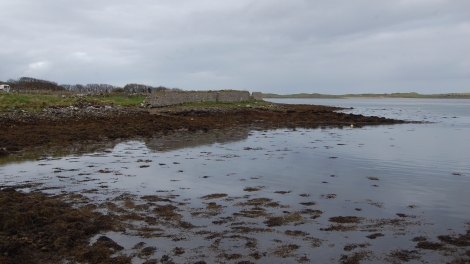On a recent trip to Sligo I was reminded of that county’s impressive archaeology and it’s salt heritage. The kind invitation of the Sligo Field Club to give a lecture on the Archaeology of Salt project, prompted a dig through the archives of that county . It was also a reminder of the challenges and finds that might be made. After our efforts in the area in 2014, one of Sligo Field Club’s members, Pat O’Brien, published an excellent overview of the county’s salt working sites in the Sligo Field Club Journal (Vol. 2, 2016). The paper highlights the importance of local archaeologists and historians and their dedication to scrutinising some of the more obscure sources and sites. Pat shed further light on some of the known sites and uncovered one at Milk Harbour that we had overlooked.

The wall and ruinous pier of the salt making site at Milk Harbour (see O’Brien 2016). Like Carrownacreevy (below) it also features a ruined lime kiln.
Without doubt the most impressive survival in the county (and the country) is 18th century complex at Streamstown on the southern shore of Ballysadare Bay, which was the subject of a previous post. Sligo town had a number of salt works listed around the Quay Street area in the 18th and 19th centuries, and Ballysadare had works in Knockmuldowney. However, in common with many urban sites these are gone, or difficult to identify. Of the rural sites, Coolbeg is definitely located although ruinous with a line of walling exposed and a few depressions in the ground showing its former position. According to Wood-Martin (1892) the site was once worked by skilled labourers that had to be brought in from the north of the country. To the west Nimmo (1822) states, ‘At Ballygilgan and Johnsport, a few yawls are kept: above that are salt works on the north shore’. Johnsport is also known as Saltport and may be the site of the works referred to. An L-shaped building is shown here on the 1st ed. OS map, which by the 20th century is two ranges.

Interior detail from the building at Johnsport. In many ways it is typical of a storehouse and yard dating to the early 19th century, but may have incorporated a salt works.
Another intriguing site is at Carrownacreevy, a few miles west of Streamstown. Labelled ‘Saltport’ on some of the maps, and ‘Corn Store’ on others it may have functioned as an out-port for the Streamstown works, being less restricted by tidal shallows than the latter site.

Carrownacreevy on the 1st ed. OS map (1837) showing the original range, and lime kiln (source: OSI).
The site comprises a large, two-storey store fronting the shoreline, a now collapsed range to the rear, and a further room running perpendicular to the main store. In this room the distinctive edge of a square plinth was noted sited centrally. Could it be the edge of a furnace for salt-making? Only further investigation could tell. Also of note in the vicinity is a collapsed lime kiln which may indicate the manufacture of salt on site – the two manufactures often noted as being linked in Ireland.

Carrownacreevy aerial photo showing the expanded building on the shoreline. The collapsed lime kiln to the north-west can also be discerned (source: Bing maps)
As a major port of the north west Sligo was a hub for maritime traffic and trade, including salt from the Medieval period. By the 18th century trade with western and southern European ports was vigorous and there was direct shipping to the Americas of passengers and foodstuffs. Charles O’Hara (c.1760) commented that fish could preserved using salt ‘made on the shore of our own ocean’. These salt works were situated around Sligo port, fishing centres such as Ballysadare and more minor harbours such as Mullaghmore, Johnsport, and Milk Harbour. As such they present some fine examples of both urban and rural sites.
See:
O’Brien, P.E. (2016) Collected Thoughts on the Salt Industry and Sligo: 1700-1850. Sligo Field Club Journal 2, 63-78.
